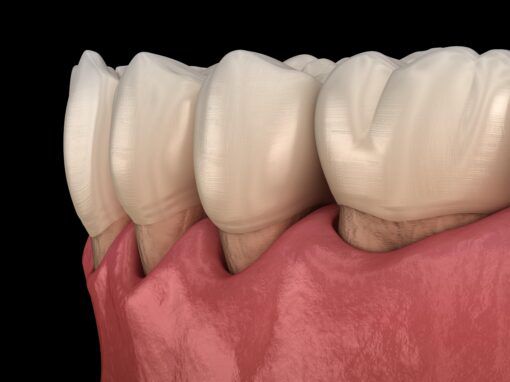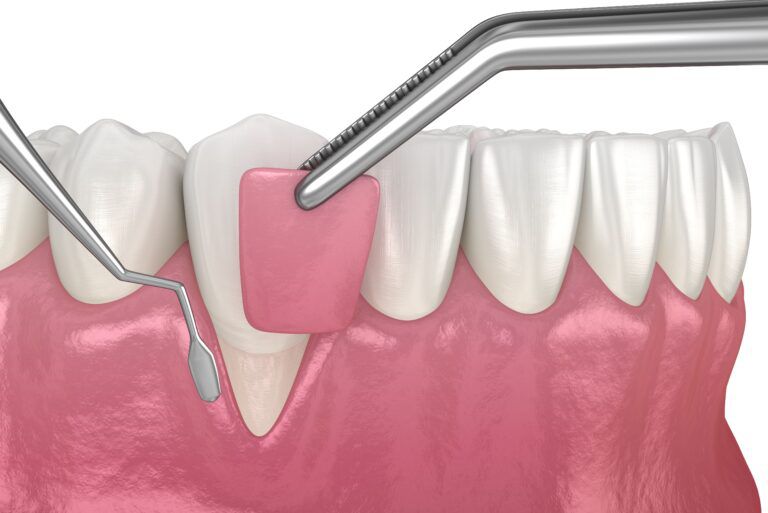Do your teeth suddenly look larger or longer than they used to? Does your gum line seem to have gotten lower? If this sounds like you, then you may be suffering from a condition called “gum recession.” Gum recession is where the teeth appear longer due to less gum coverage. It can also lead to pain and inflammation in the area, even sometimes bleeding when brushing or flossing. So, what should you do if you have receding gums? This blog will answer all of these questions for you!

What are receding gums?
Receding gums are a common problem that many people experience. Gum recession is when the gum pulls away from around the tooth roots. This exposes more of your tooth roots, which leads to your teeth looking longer. Gum recession also causes your gums to look “loose” around the base of your teeth and can be accompanied by a red color.
Because gum recession exposes the tooth roots, it makes your teeth more susceptible to decay. You see, tooth roots have a very thin layer of enamel and decay much faster than the rest of the tooth. Not only that, but gum recession also causes periodontal pockets to form. Periodontal pockets are spaces between the teeth and gums that form when the gums pull away from the teeth. These pockets can become a haven for bacteria, which makes gum recession worse and can cause inflammation as well as bone loss.
What causes gum recession?
There are many factors that can contribute to gum recession. Some of the most common include:
- Brushing too hard or using a toothbrush with stiff bristles can wear away the gums over time and lead to recession.
- Injury to the gums can cause them to recede.
- Poor oral hygiene can also lead to gum recession as bacteria and plaque can build up on the teeth and gums, leading to inflammation and bone loss.
- Smoking is a major risk factor for gum recession as it causes the gums to become dry and irritated. Nicotine also impairs the healing process and reduces blood flow to the gums.
- Teeth grinding or clenching, also called bruxism, can cause the gums to recede.
- Genetics may also play a role in gum recession as some people are more prone to it than others.

How can you treat gum recession?
If you have been diagnosed with gum recession, there are several treatment options available. Depending on the severity of your recession, your dentist may recommend these common treatments:
Scaling and Root Planing
If you have periodontal pockets, your dentist may recommend a deep cleaning, also called scaling and root planing. This is a procedure where the dentist scrapes off the plaque and tartar from the tooth roots to help stop further gum recession. Then, your dentist will smooth the surface of the tooth roots to make it harder for plaque to accumulate. In some cases, antibiotics may also be placed in the gum pockets.
Gum Graft
If you have significant gum recession, your dentist may suggest a gum graft. A gum graft is a surgical procedure where tissue is taken from another part of the mouth and transplanted to cover your tooth roots, which will stop further gum recession. Gum grafts also prevent bone loss and decrease the risk of cavities forming on the tooth roots.
What can you do at home?
If you have been diagnosed with receding gums, there are a few things you can do at home that may help. Here are some tips:
- Use a soft bristled toothbrush when brushing your teeth.
- Brush your teeth gently and make sure to brush along the gum line.
- Floss regularly to remove plaque and bacteria from in between your teeth.
- Avoid smoking as it can dry out your gums and irritate them.
- Limit your intake of sugary foods and drinks as they can increase the amount of bacteria in your mouth and contribute to gum recession.
- See your dentist regularly for a professional cleaning and check-up.
In Conclusion
Receding gums are a common problem that many people experience. Gum recession is when the gum pulls away from around the tooth roots, exposing more of your tooth roots and making them susceptible to decay. There are several treatment options available for gum recession depending on the severity of recessions so it’s important to see your dentist if you have been diagnosed with this condition. If you have been diagnosed with receding gums there are also some things you can do at home to improve your gum health.



